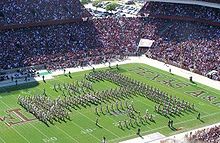Marching band
The Marching Band [ ˈmaːtʃɪŋ ˈbænd ] is a special form of the wind orchestra whose members march to music. The size of marching bands varies between 20 and 500 people. The line-up usually includes brass instruments , woodwind instruments , drums, and percussion . Some marching bands are supplemented by show dance groups, and uniforms are often worn.
history
The Marching Band was formed in the USA after the end of the civil war on a military level. One of the co-founders is John Philip Sousa . The style of the music was initially military marching songs . After the end of the Second World War , more private and school marching bands were formed. The direction of the modern marching bands emerged in the 1960s. Since the style of modern marching bands is rooted in the USA, many names and terms have been adopted from English without translation. The oldest German marching band ("The Sound of Frankfurt") was founded in the 1960s and is still in existence today. Recently, marching bands have been increasingly used at folk festivals to perform popular music and the marching band related show.
Mark
The repertoire of marching bands consists of compositions from pop , blues , marching music and old-time jazz . Today you can usually recognize the marching bands by their uniforms , music and show. Non-marching marching bands are called pep bands .
occupation
- Rhythm group : percussion (or bass drum , quint , snare drum , cymbals and pit - but only to be seen at field shows)
- Woodwinds : Saxophone , clarinet , transverse and piccolos
- Brass : trumpets , mellophones , trombones , tenor horn , euphonium , sousaphones
- Color Guard : Show dancer with flags, rifles, sabers and botons
- Drum major : consists of one or more drum majors
